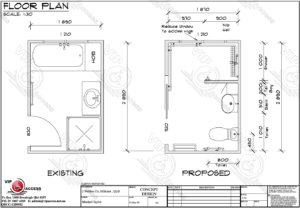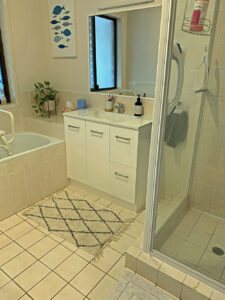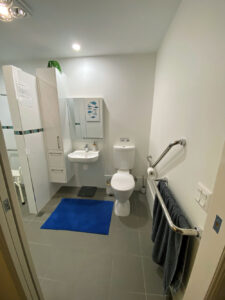 Mitchell’s second NDIS Plan – in the second half of 2019 – was a short one, just six months. The NDIA wanted us to focus on compiling the evidence they wanted to ‘confirm’ Mitchell’s needs. We worked with:
Mitchell’s second NDIS Plan – in the second half of 2019 – was a short one, just six months. The NDIA wanted us to focus on compiling the evidence they wanted to ‘confirm’ Mitchell’s needs. We worked with:
- an occupational therapist to put together a “Functional Capacity and Needs Assessment” (a 20-page document) and
- a psychologist to put together a “Psychology – Functional Assessment Report” (a 15-page document).
Together, these documents took about 50 hours of effort and laid the groundwork for establishing how Mitchell should live. Specifically – for this post – they made the case for Mitchell needing an accessible bathroom.

In the leadup to the planning meeting for Mitchell’s third NDIS Plan, an acquaintance suggested the NDIA would not fund a home modification as we had purchased the home for Mitchell after he was granted access to the NDIS. However, a closer examination of NDIS guidance on home modifications↗ did not quite say that, to quote that guidance:
The NDIS will generally not fund … modifications for a property purchased after a participant was granted access to the NDIS, unless the NDIA was involved in the decision to purchase the property, or the purchase of a more accessible property was not possible.
The last part of that sentence was valuable for us making the case for a home modification to be included in Mitchell’s third NDIS Plan. In the planning meeting, the map we had produced to guide our search for Mitchell’s new home↗ helped guide the conversation. It turned general statements about accessible housing developments into a focus on the importance of Mitchell’s access to his family and informal supports.
The map … turned general statements about accessible housing developments into a focus on the importance of Mitchell’s access to his family and informal supports.

Also, the advice Mitchell’s occupational therapist had given us when we were searching for his new home added weight to our case for funding to modify Mitchell’s new home. You can read the words we put together below.
The result was Mitchell received approval for a home modification in his third NDIS Plan. It took about 10 months for the physical work to commence, but two weeks later Mitchell had a wonderful, fully accessible bathroom thanks to a company by the name of VIP Access↗.
Finding Mitchell’s House – Narrative for the Plan Review
- Looked for a suitable property between November 2018 and January 2019.
- The main purpose of this property (in support of Mitchell’ goals) is to provide Mitchell with the most physically and sensory supportive environment possible, thus increasing his well-being and building his independence into the future. Started with advice on Queensland Government’s “Finding an accessible property to buy or rent” (click here🔗) regarding design features and used that as initial instructions to real estate agents.
- The property search area was limited to maintain ready access to family and existing informal supports.
- No properties where found in the search area that had the key desired feature – an accessible bathroom.
- The available budget necessitated a trade-off on property features – number of bedrooms, ready access.
- The selected property (settled early 2019) presented the best compromise in terms of proximity to family and informal supports, features and affordability:
- The property is lowset and featured an open plan design that met Mitchell’s mobility needs.
- The property was located away from major roads, avoiding constant traffic noise.
- The mortgage Mitchell’s parents needed to take out was at the upper limit of their budget but could be afforded.
- Available funds allowed for a basic refresh of the property inside and out. The property required minimal adaptions (apart from the bathroom) to suit Mitchell’s needs and so presented value for money.
- The major outstanding need in the property is an accessible bathroom. It is hoped this will be covered in Mitchell’s second NDIS Plan.
- Given Specialist Disability Accommodation no longer needs to be pursued for Mitchell, funding an accessible bathroom represents value-for-money.
So what are “informal supports”?
Informal supports is NDIS-speak for family, friends, and community networks who support someone↗ with a disability. What the NDIA are actually talking about are the people and services they don’t have to pay for.